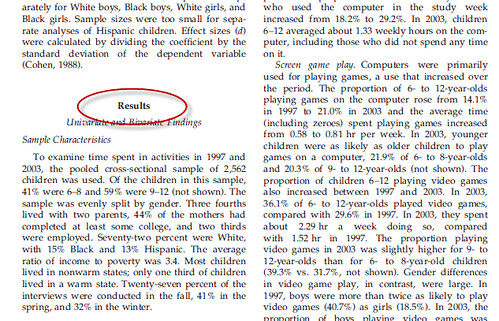Use the citation information to help determine if an article is published in a journal. The information about the article, such as the journal title, volume, issue, and pages is usually on the first page of the article. You will need this information to cite the article correctly in your paper. Sometimes you can tell that the article is scholarly just by the name of the journal, but not always. Scholarly articles are generally long so looking at the number of pages is one indicator that it is scholarly.

You may also want to find out more about the journal in which the article was published. For example, you may want to know if the article is in a peer-reviewed journal.
Information about the author or authors can help you determine if an article is scholarly. In a research article, the authors will list their affiliation, usually with a university or research institution. In this example, the author's affiliation is shown on the first page of the article. In a research article, you will never have an anonymous author.
.
An abstract is a summary of the main article. An abstract will include information about why the research study was done, what the methodology was and something about the findings of the author(s). The abstract is always at the beginning of the article and will either be labeled "abstract" or will be set apart from the rest of the article by a different font or margins.

The abstract should tell you what the research study is about, how the research was done (methodology), who the research sample was, what the authors found out and why this is important to the field.
In many articles there are key words or terms that describe the content of the article. This is another good place to look for additional search terms.

Some research is sponsored by an institution, such as the U.S. government or a non-profit or private company. If the research project is sponsored by someone, you will want to investigate who that is and if that could impact how the research was done. For example, a pharmaceutical company that sponsors research on a particular medication may mean that the research is not entirely bias-free.

Most articles will start with an introductory section, which may be labeled introduction. This section introduces the research study, the thesis statement and why the research being conducted is important.
Questions to ask while you read:

The literature review section of an article is a summary or analysis of all the research the author read before doing their own research. This section may be part of the introduction or in a section called Background. It provides the background on who has done related research, what that research has or has not uncovered, and how the current research contributes to the conversation on the topic. When you read the literature review ask:

The literature review is also a good place to find other sources you may want to read on this topic to help you get the bigger picture.
The methodology section or methods section tells you how the author(s) went about doing their research. It should let you know a) what method they used to gather data (survey, interviews, experiments, etc.), why they chose this method, and what the limitations are to this method.
The methodology section should be detailed enough that another researcher could replicate the study described. When you read the methodology or methods section:

A good researcher will always let you know about the limitations of their research.
Research articles are full of data. The data should be complete and directly support the conclusions the authors' draw about their research question.
Tables, graphs, and charts are good indicators that this is a research article. The tables should represent the data in a clear and readable manner.

The results section in a scholarly article is where the author(s) talk about what they found in their research study. Most scholarly articles will have a section labeled results or findings.

The discussion section is where the author(s) write about what they found and what they think it means. The authors may also draw some conclusions about the research and what significance it has in this section. This section will also tell you what some of the issues were with the research or using a specific population for a research study.

The final section is usually called the conclusion or recommendations. Here is where the authors summarize what they found, why they think their research is significant and, if appropriate, make recommendations about future actions or future research that needs to be conducted. In some cases, the conclusion is part of the discussion section.
